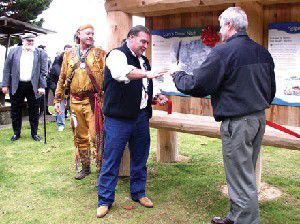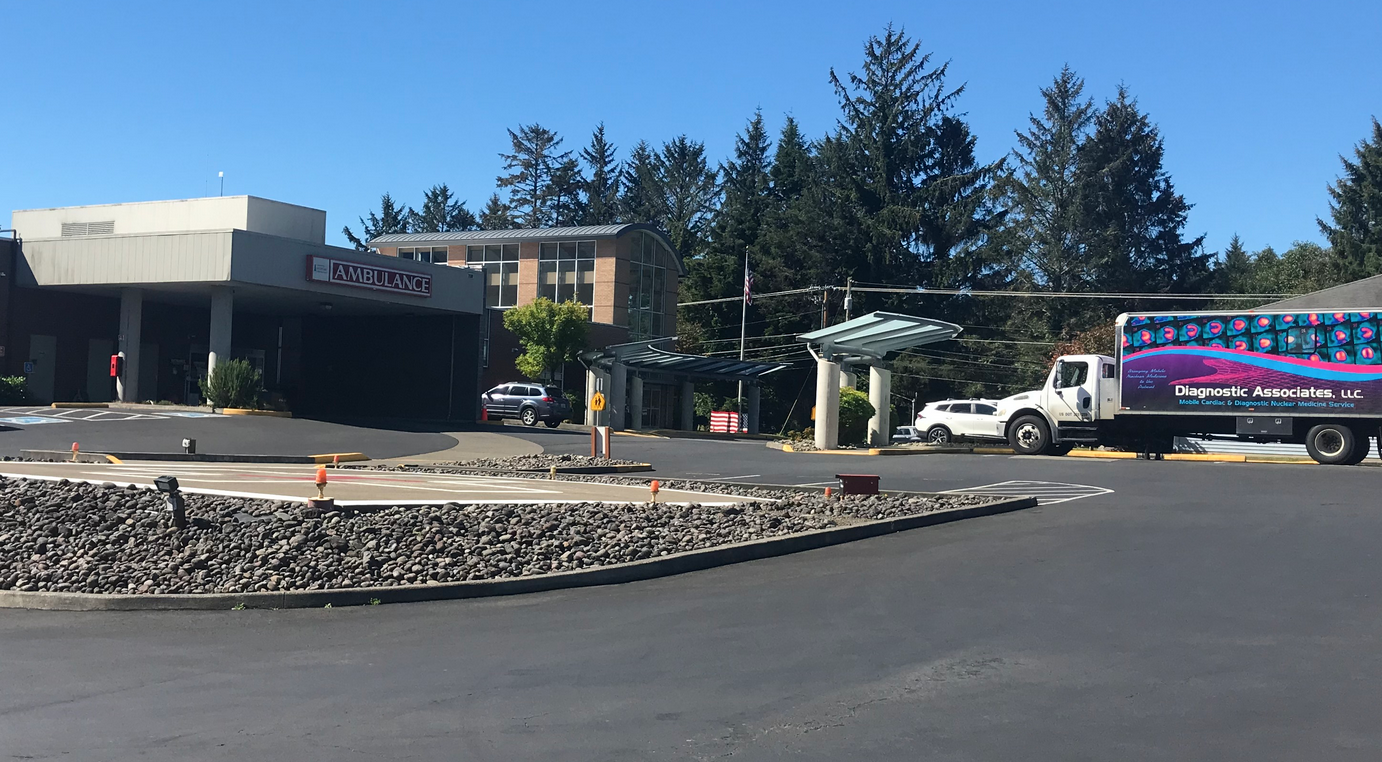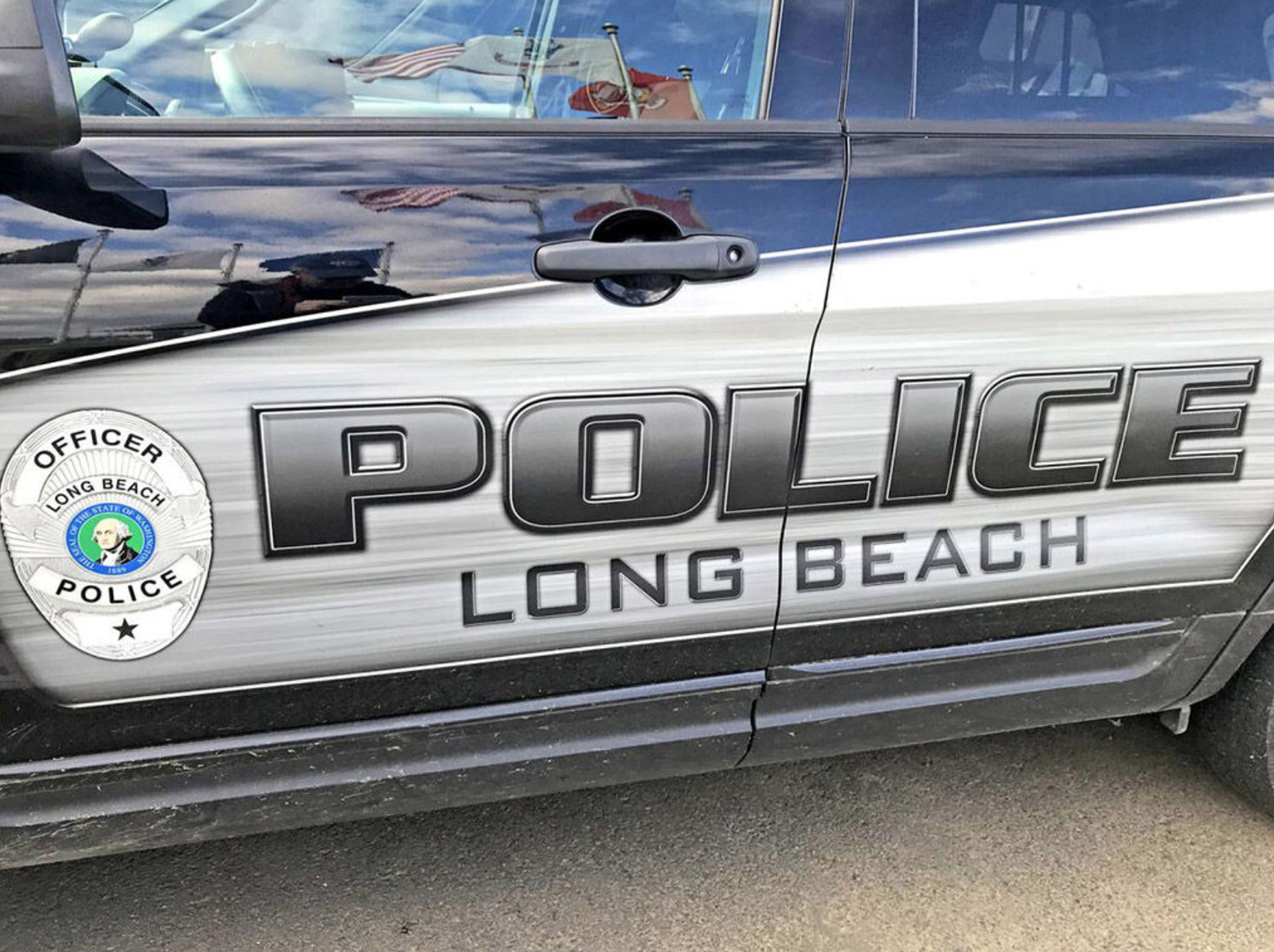Relive America’s epic adventure here
Published 4:00 pm Monday, December 27, 2004

- Ray Gardner of the Chinook Indian Tribe's cultural committee and U.S. Rep. Brian Baird cut a ribbon in October 2004, officially opening Clark's Dismal Nitch. The park at the Megler Rest and Safety Area, east of the Astoria-Megler Bridge, now is part of the nation's newest national park - Lewis and Clark National and State Historical Parks - that also includes the Station Camp site and a portion of Cape Disappointment State Park on the north side of the Columbia River. The big knife used to cut the ribbon was provided by Roger Wendlick of Lewis and Clark College in Portland, in costume as George Drouillard, considered one of the most important members of the Lewis and Clark Expedition. On Nov. 11-15, 2005, Pacific and Clatsop counties will play host to the Signature Event commemorating the expedition's arrival at the Pacific in November 1805. NANCY BUTTERFIELD photo
They had traveled a very long way following a dream and now – wet, hungry and tired – they stood before the pounding Pacific surf. They were members of an expedition which fires the American imagination, the famous Corps of Discovery. Two hundred years later, their perilous journey still spurs modern adventurers to follow the footsteps of these brave adventurers.
Trending
As is true in all great epic tales, the heroes – Captains Meriwether Lewis, William Clark and their followers – had a very specific purpose, in this case fulfilling the vision of President Thomas Jefferson. For the new nation’s president, the goal was to find a water route which would take the commerce of the growing young America to the end of the Missouri River and all the way to the Pacific Ocean, where vessels of many nations already plied the waters carrying goods and wealth. Jefferson’s ‘Holy Grail’ was the famed “Northwest Passage,” believed to be a short hop across a small mountain range beyond the terminus of the Missouri. For the Corps of Discovery, it had turned into a pipe dream. Yet they continued on, persevering against heavy odds.
It was a journey filled with perils no less formidable than the dragons which breathed fire on legendary knights of old. Tales from the journals kept by expedition members are full of encounters with wild animals, harsh weather and personal challenges. There were accidents, fierce winter snows, severe winds, insurgence in the ranks, loss of valuable equipment, encounters with sometimes dangerous strangers, long punishing days of physical labor, the constant push westward. Some 3,700 miles, one year and half of another had passed since they first left, cheered on by their countrymen, to explore the continent in greater detail than ever before.
It requires a stretch of the imagination today to envision what these explorers encountered and what condition they were in by the time they reached the West Coast. Their expectation of catching a ship headed back toward ‘civilization’ was dashed when they arrived; it was already November, the seas were treacherous and the rains nearly constant. As they stared out past the roiling gray surf at what would one day become Long Beach, Wash., they digested the information they had learned from the locals – no ships would be found until spring and better weather.
Trending
So there they stood, their clothes no doubt full of lice, torn, patched and repatched, wet and clammy. It was pouring “cats and dogs,” as we would say. Besides the local berries and some rotten dried fish, they were having difficulty finding enough meat to provide the level of protein each man needed to work in the harsh elements each day. Creating a nice, warm fire in front of which to warm one’s hands was nearly impossible most of the time.
They had followed their grail and now, exhausted from the effort, they were at another of those junctures which face all heroes sooner or later. Should they turn back now? Should they file away the president’s exhaustive list of questions, pack up their scrubby feeble belongings and head east, short even of the necessary trade goods which they would need to help them buy food, ponies, supplies as they headed home? Or should they cling to the goal and find a way to stay the winter in this seemingly inhospitable place?
The captains of this military expedition must have known that the decision about what to do next could determine the life or death of the men, woman and child under their charge. Breaking from tradition, they allowed each to cast a vote, regardless of race, sex, or status in the party. The occasion at Station Camp must have been a solemn one, with each vote being recorded in writing and any particularly significant individual comments added alongside the person’s name. Two hundred years later, this vote echoes down the long canyons of time to symbolize the democratic spirit. Following the majority of the party, the captains decided to risk the treacherous Columbia River and cross to examine land on its south flank.
That monumental decision resulted in the creation of Fort Clatsop just outside modern-day Astoria, Ore., their winter home and now the centerpiece of the recently proclaimed new Lewis and Clark National and State Historical Park. The park also encompasses the Dismal Nitch site on the Washington side as well as Station Camp and Cape Disappointment State Park with its showcase Lewis & Clark Interpretive Center.
The adventures of the Corps of Discovery at the mouth of the Pacific Ocean, from the time they first arrived on the Washington side of the Columbia River until their departure in the spring of 1805, included encounters with seemingly prehistoric beasts such as the gray whale and the California condor to the more benign labor of creating salt from the ocean’s bounty. While the “Holy Grail” may never have materialized, the Corps of Discovery experienced a land and time which was mythic in scope. Here, at the western edge of the known continent, they walked among trees which were adults before the boy Jesus had been born in Bethlehem. They met with native people who had maintained a thriving trade network far inland and to the north for dozens of generations. Most importantly, they were able to return to the president with the news that they had gone all the way to the Pacific Ocean, followed his instructions to the letter, and explored the land for him in incredible detail, bringing home a wealth of tales of adventure as well as knowledge with which to enrich the world.
Today, as we walk among the trees and wiggle our toes in sandy Pacific beaches, we are blessed to be able to see much that those brave explorers reported in 1805-06. From Discovery Trail on the Long Beach Peninsula to the Fort to Sea Trail at Fort Clatsop, we can smell salt in the sea air, listen to the rustle of the trees, watch waves crash upon the shore. These experiences link us to the times when native peoples lived and thrived here and watched these new Americans forge their way into a new country, this beautiful Northwest territory.
The adventures of the Corps of Discovery at the mouth of the Pacific Ocean, from the time they first arrived on the Washington side of the Columbia River until their departure in the spring of 1805, included encounters with seemingly prehistoric beasts such as the gray whale and the California condor to the more benign labor of extracting salt from the ocean’s bounty.
While the “Holy Grail” may never have materialized, the Corps of Discovery experienced a land and time which was mythic in scope. Here, at the western edge of the known continent, they walked among trees which were adults before the boy Jesus had been born in Bethlehem. They met with native people who had maintained a thriving trade network far inland and to the north for dozens of generations. Most importantly, they were able to return to the president with the news that they had gone all the way to the Pacific Ocean, followed his instructions to the letter, and explored the land for him in incredible detail, bringing home a wealth of tales of adventure as well as knowledge with which to enrich the world.
Today, as we walk among the trees and wiggle our toes in sandy Pacific beaches, we are blessed to be able to see much that those brave explorers reported in 1805-06. From Discovery Trail on the Long Beach Peninsula to the Fort to Sea Trail at Fort Clatsop, we can smell salt in the sea air, listen to the rustle of the trees, watch waves crash upon the shore. These experiences link us to the times when native peoples lived and thrived here and watched these new Americans forge their way into a new country, this beautiful Northwest territory.
-Una Boyle
Executive Director, Long Beach Peninsula Visitors Bureau









